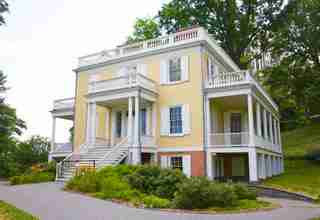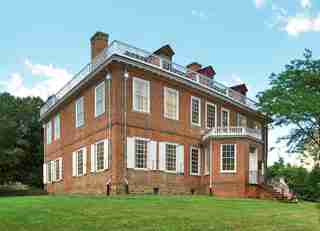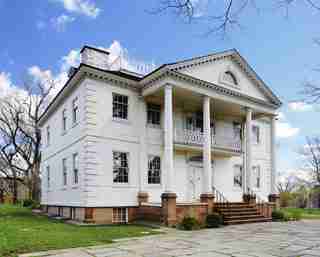With the tremendous popularity of the Broadway musical Hamilton , Alexander Hamilton seems to be at the forefront of everyone’s minds these days. Despite the fact that the founding father lived more than two centuries ago, there are still plenty of Hamilton-related sites in existence today—and you can visit many of them. We followed his path from a two-story stone home on the Caribbean island of Nevis all the way to Federal Hall on Wall Street in Manhattan. If you can’t snag a ticket to the in-demand musical, check out our guide to all buildings Hamilton and immerse yourself in his history.

Hamilton Grange, New York City
Hamilton commissioned John McComb Jr. to build this two-story Federal-style house on his 32-acre estate in Upper Manhattan. The Grange, as it’s known, takes its name from Hamilton’s grandfather’s estate in Ayrshire, Scotland. It was completed in 1802, just two years before Hamilton’s death: It was the only home ever owned by Hamilton, and it remained in his family for 30 years after he died. Today it’s part of the National Parks Service and offers free admission and tours. 414 W. 141st St., New York City; nps.gov

Schuyler Mansion, Albany, New York
Revolutionary War general Philip Schuyler began construction on his Georgian-style estate in Albany in 1761. Schuyler and his wife moved into the house with their family, including daughter Elizabeth, who married Hamilton at the home on December 14, 1780. Today, the house is a museum and an official National Historic Landmark. 32 Catherine St., Albany, New York; nysparkom

The Morris-Jumel Mansion, New York City
Built in 1765 by Colonel Roger Morris, this estate served as a summer villa on a property that stretched from the Harlem River to the Hudson. When the American Revolution broke out, the house was occupied by George Washington and his officers, including Hamilton (who was his aide-de-camp); it was later home to British troops. In 1810 French merchant Stephen Jumel and his wife Eliza Bowen purchased the house; after Jumel died, Bowen married Vice President Aaron Burr, who later killed Hamilton in a duel. The City of New York purchased the house in 1904 and turned it into a museum. 65 Jumel Terrace, New York City; morrisjumelrg
Federal Hall, Wall Street, New York City
It was at Federal Hall on Wall Street that George Washington took the oath of office as the first U.S. president. The site was also home to the many other firsts: Congress, the Supreme Court, and the executive branch offices of the government. The original building was demolished in 1812, but the current structure, a customhouse, served as part of the U.S. Sub-Treasury and today is a museum and memorial to the beginnings of the national government. 26 Wall St., New York City; nps.gov
Hamilton’s Childhood Home in Charlestown, Nevis
This modest Georgian-style building was the birthplace of Hamilton, who lived in Nevis from 1755 to 1772, when he left for America. Built around 1680, the structure was destroyed in an earthquake in 1840 and restored in 1983. Today it’s known as Hamilton House and is home to the Museum of Nevis History, which includes an exhibit on the life and times of Hamilton, as well as the meeting room for the Nevis House of Assembly. Main Street, Charlestown, Nevis; nevisislandom
First Bank of the United States, Philadelphia
The First Bank of the United States, built in Philadelphia between 1795 and 1797, was the brainchild of Hamilton, who, at the age of 23, wrote a lengthy report arguing the necessity for a national bank to allow for raising capital and managing the nation’s finances. He defended the bank’s constitutionality in order to have the bank bill signed into law, which led to the founding of the first financial institution on the North American continent. 116 S. Third St., Philadelphia; nps.gov
Liberty Hall, Union, New Jersey
Built in 1772, this house was originally a 14-room Georgian-style building, but today stands as a 50-room Victorian Italianate mansion. Liberty Hall has been home to many historic figures, including William Livingston, the first governor of New Jersey. During the first year of Livingston’s occupancy, Hamilton, who was then a student at the Academy in nearby Elizabethtown, visited the home. The building is now the Liberty Hall Museum. 1003 Morris Ave., Union, New Jersey; keandu
